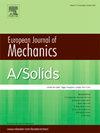Overcoming limitations of electrostatic bow snap-through in bistable microbeams via prestress tuning
IF 4.2
2区 工程技术
Q1 MECHANICS
引用次数: 0
Abstract
A curved bistable microbeam subjected to electrostatic loading from an electrode facing its concave side may exhibit a bow snap-through () response, depending on the applied voltage, initial conditions, and beam geometry. However, for stress-free microbeams, achieving has been shown to be quite challenging, since the conditions required for a successful actuation are limited. In the present work, is studied in the presence of prestress, enabling the development of expanded necessary conditions and upper bounds for . The conditions are derived using an undamped, single-degree-of-freedom (DoF) reduced-order (RO) model, obtained via Galerkin’s decomposition. Subsequent analysis of the acquired conditions reveals that the introduction of prestress can be leveraged to tune the behaviour of a microbeam and overcome the constraints inherent to the stress-free beam. More specifically, it is shown that compressive prestress can increase the design-initial conditions space where can be achieved, facilitating a controlled equilibrium shift in bistable structures via bow actuation. These new insights and conditions provide practical guidelines for both researchers and engineers in designing and tuning microbeams using prestress, thus overcoming the limitations of a stress-free beam and obtain a successful , supporting the development of efficient, nonvolatile, and low-power bistable devices.

通过预应力调谐克服双稳微梁静电弓通断的局限性
一个弯曲的双稳态微光束受到来自电极的静电载荷,面对其凹侧,可能会表现出弓形卡通(BST)响应,这取决于施加的电压,初始条件和光束的几何形状。然而,对于无应力微梁,由于成功驱动所需的条件有限,实现BST已被证明是相当具有挑战性的。在本工作中,研究了存在预应力的BST,使得BST的必要条件和上界得到了扩展。这些条件是通过伽辽金分解得到的无阻尼单自由度降阶(RO)模型得到的。对所获得条件的后续分析表明,可以利用预应力的引入来调整微梁的行为,并克服无应力梁固有的约束。更具体地说,研究表明,压缩预应力可以增加设计初始条件空间,从而实现BST,从而通过弓形驱动促进双稳结构的可控平衡转移。这些新的见解和条件为研究人员和工程师使用预应力设计和调谐微光束提供了实用指南,从而克服了无应力梁的局限性,获得了成功的BST,支持了高效、非易失性和低功耗双稳器件的开发。
本文章由计算机程序翻译,如有差异,请以英文原文为准。
求助全文
约1分钟内获得全文
求助全文
来源期刊
CiteScore
7.00
自引率
7.30%
发文量
275
审稿时长
48 days
期刊介绍:
The European Journal of Mechanics endash; A/Solids continues to publish articles in English in all areas of Solid Mechanics from the physical and mathematical basis to materials engineering, technological applications and methods of modern computational mechanics, both pure and applied research.

 求助内容:
求助内容: 应助结果提醒方式:
应助结果提醒方式:


